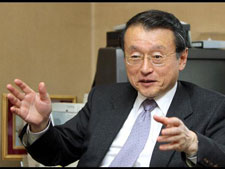China The Most Powerful Investment Trend for the Next Decade
Stock-Markets / Chinese Stock Market Jul 22, 2009 - 04:18 AM GMTBy: Uncommon_Wisdom
 Tony Sagami writes: Sometimes you have to connect a few dots to see the big picture. That was especially true last week. Now I see the unfolding of the single, most powerful investment trend for the next decade.
Tony Sagami writes: Sometimes you have to connect a few dots to see the big picture. That was especially true last week. Now I see the unfolding of the single, most powerful investment trend for the next decade.
Here’s what I’m talking about …
Dot #1 — Take the Dollar And Shove It!
After watching our politicians bail out company after company, spend trillions on unproductive stimulus programs, raise taxes through Tax and Kill (Cap and Trade), and spend trillions more on health care reform, foreign investors are just plain fed up!
Can you blame them? After all the U.S. government’s national debt has hit a mind-blowing $11.5 TRILLION and is growing at the rate of about $3.88 billion a day.
That doesn’t even include the seldom-mentioned balance sheet of the Federal Reserve Bank, whose debt load has ballooned from $860 billion in September 2008 to more than $2 trillion today.
Debt, debt, debt …
That’s why China, India, Russia, Brazil, Mexico and South Africa have challenged the U.S. dollar as the primary denomination of world reserves.
 |
| “In the medium to long term, we need to do what we can to avoid the risk of currency losses or economic turbulence that could result if the dollar were to swing.”
— Masaharu Nakagawa |
Just last week Masaharu Nakagawa, the finance minister in the Democratic Party of Japan, flat out destroyed the dollar when he publicly recommended that Japan shift its $1 trillion of foreign reserves away from the dollar and buy International Monetary Fund bonds instead.
With $686 billion worth of our Treasury bonds, Japan is the second largest holder of U.S. government debt — after China — so any shift in confidence could be disastrous for the greenback.
I don’t expect China, Japan, Russia, India, Brazil, Mexico, and South Africa to start panic-dumping their dollars. But they’re certainly looking for some place other than U.S. dollars to stash their new reserves.
Dot #2 — $2.1 Trillion … And Counting
Talking about new reserves, China disclosed last week that their horde of foreign cash reserves ballooned to $2.1 TRILLION … an historic high!
Those trillions are sloshing around in the Chinese economy, too. In fact, China’s M2 money supply has grown by 28.5 percent on a year-over-year basis in 2009.
Like a car needs gas to run, an economy needs money. And China has both a mountain of cash and growth-inducing monetary liquidity pulsing through its economy …
In the second quarter of this year, China pulled in a record $178 billion. This clearly shows that despite the slowdown in sales to the U.S., the rest of the world is picking up the slack … and then some.
Dot #3 — Chinese Economy Comes Roaring Back
China’s National Bureau of Statistics announced last week that the gross domestic product (GDP) was 6.1 percent for the first quarter of this year. And for the second quarter it hit 7.9 percent.
 |
| China’s stimulus program focuses on infrastructure projects. And it’s working like a charm. |
So the Chinese economy actually accelerated in the second quarter. And I expect that acceleration to continue for the rest of the year.
Unlike the U.S., China’s $586 billion stimulus program is working like a charm. That’s probably because they didn’t have to borrow any of the money. What’s more, they spent it on key, productive infrastructure projects instead of bailing out failing banks, shaky insurance companies, greedy brokers, and antiquated auto makers.
Here’s What I See When I Connect These Three Dots …
I see the most powerful and most profitable trends that will define your investment success (or lack thereof) for the next decade …
I see that investments like U.S. stocks and U.S. bonds are headed for big, big trouble. Anything priced in U.S. dollars is going to fall in value just because of currency losses.
Conversely, the currencies of strong, growing, fiscally sound economies are going to do quite well. And assets priced in those currencies will enjoy currency appreciation.
What I’m talking about is getting the heck out of investments that are denominated in U.S. dollars and moving them into growing, vibrant, healthy economies.
Which economies are the strong ones?
Definitely China. And countries like India, Brazil, Australia, Canada, and Taiwan, too. These are the countries where you should consider concentrating your investment dollars.
 |
| ETFs make it easy to invest in strong countries like China and Brazil. |
Remember: Your investment feet aren’t stuck in cement. And if you’re like many American investors, you have most, if not all, of your investment dollars concentrated in U.S. stocks and U.S. bonds.
Investing in the strong countries I just named is easy through mutual funds, foreign stocks listed on the New York Stock Exchange and Nasdaq, and exchange traded funds (ETFs).
For example, here are three ETFs that are focused just on China …
iShares FTSE/Xinhua China 25 Index (FXI): Seeks to track the performance of the FTSE/Xinhua China 25 index. This index consists of 25 companies that represent the largest 25 Chinese companies listed on the Hong Kong Stock Exchange.
PowerShares Golden Dragon Halter USX China (PGJ): Seeks results that correspond to the returns of the Halter USX China index. This index consists of 103 Chinese companies whose common stock is publicly traded in the U.S. The index uses a formula that prevents the largest market-cap companies from becoming too large a component of the index.
SPDR S&P China (GXC): Seeks to replicate the total return performance of the S&P/Citigroup BMI China index. This index consists of the largest 342 companies that are publicly traded and domiciled in China.
When it comes to investing in China, I also suggest you consider individual stocks. I say that because a large number of Chinese companies are controlled and operated by the Chinese Communist Party.
Look … I don’t trust communist politicians any more than I trust U.S. politicians, and the above three ETFs include a heavy dose of those state-owned enterprises.
But ask yourself this question, then answer either A or B …
Does it make more sense to invest in:
- Companies that are up to their eyeballs in red ink, that continually beg for government bailouts to stay afloat, and that are hamstrung by the same politicians who control those bailouts.
Or …
- Companies that are run by hard-working Chinese entrepreneurs who live and die with their companies, like New Oriental Education (NYSE:EDU) and Duoyuan Global Water (NYSE:DGW).
I think the answer is obvious.
Best regards,
Tony
This investment news is brought to you by Uncommon Wisdom. Uncommon Wisdom is a free daily investment newsletter from Weiss Research analysts offering the latest investing news and financial insights for the stock market, precious metals, natural resources, Asian and South American markets. From time to time, the authors of Uncommon Wisdom also cover other topics they feel can contribute to making you healthy, wealthy and wise. To view archives or subscribe, visit http://www.uncommonwisdomdaily.com.
Uncommon Wisdom Archive |
© 2005-2022 http://www.MarketOracle.co.uk - The Market Oracle is a FREE Daily Financial Markets Analysis & Forecasting online publication.



